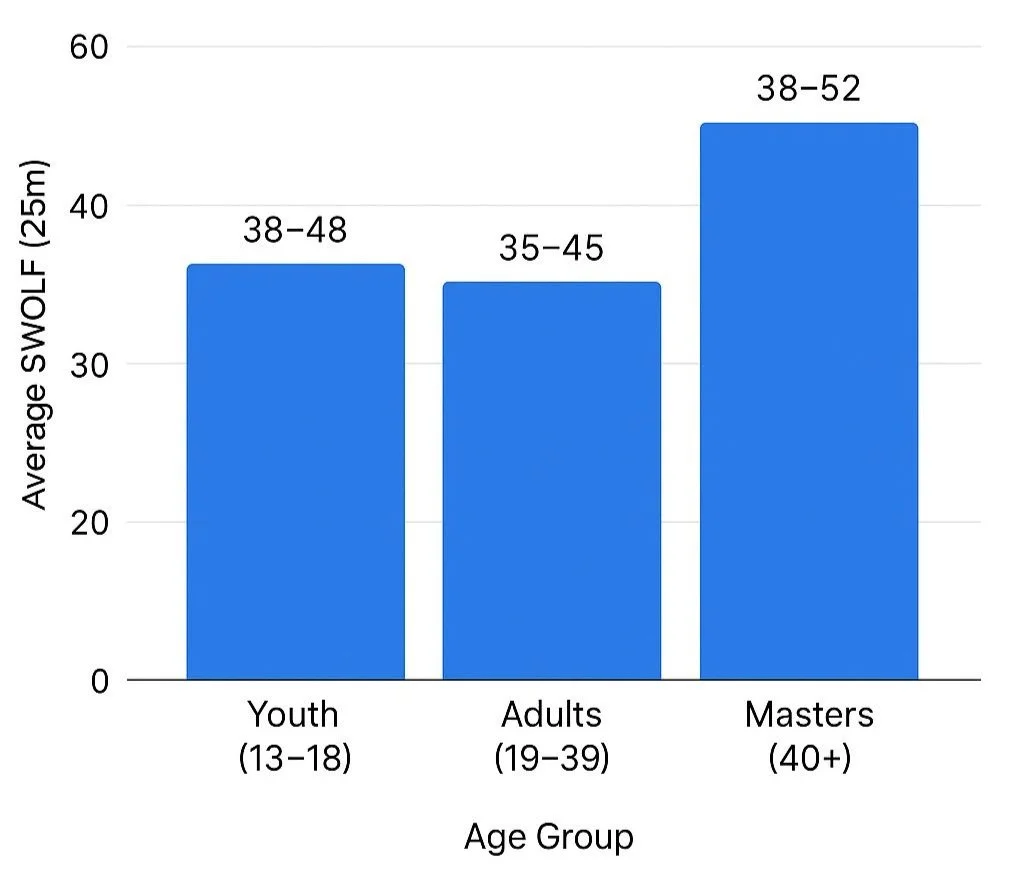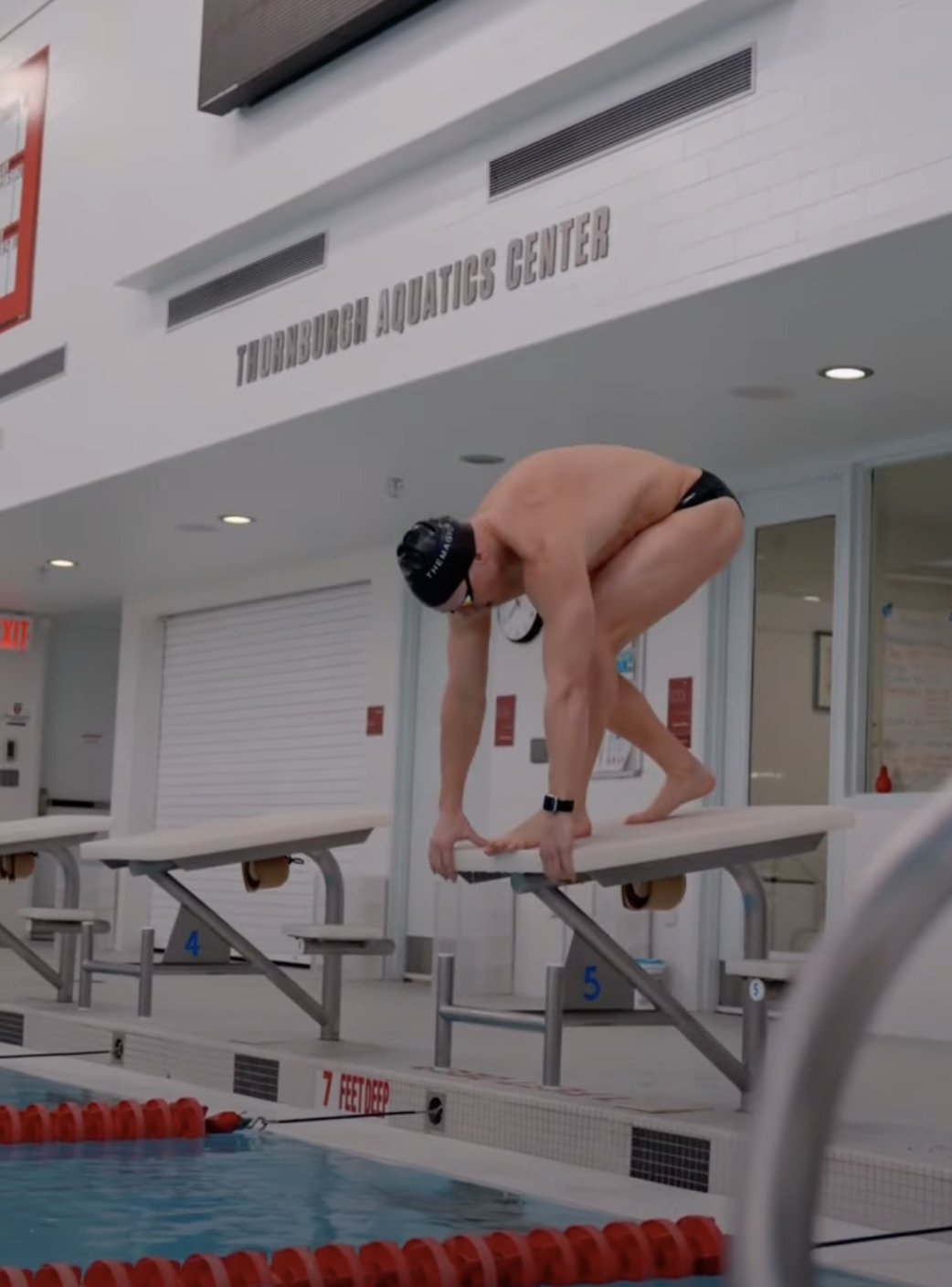SWOLF in Swimming: How to Calculate It and Use It to Get Faster
/What’s your kick, stroke, and breath count for 50m freestyle?
I recently did 10×50 on 1:30, long and easy, no breath, 5 kicks off the wall, 39 strokes, in :39 seconds.
That’s a perfect example of how stroke efficiency - not just speed - drives performance.
50m freestyle: I did 10x50 on 1:30 no breath long and easy 5 kicks off the wall 39 strokes :39
If you’ve ever finished a set wondering why your effort didn’t match your time, you’re not alone. Many swimmers hit plateaus not because they’re unfit - but because they’re inefficient. I’ve seen this firsthand coaching everyone from high school sprinters to masters triathletes. They push hard, they swim often… but something’s missing.
That “something” is usually stroke efficiency. And that’s where SWOLF comes in.
SWOLF - short for “Swim Golf” - combines your lap time and stroke count to give a simple score. It’s not just a number for your watch to flash at the end of a set. When used correctly, SWOLF is a powerful feedback tool that reveals how well your body moves through water. It’s the closest thing we have to a swim “efficiency rating” - and understanding it can take your training from scattered to strategic.
What Most Swimmers Get Wrong
Most swimmers look at the pace clock. Some track stroke count. Few connect the two. That’s the blind spot.
Here’s what I tell my athletes: Speed alone is a blunt tool. Efficiency is your scalpel.
If your SWOLF score is rising as you fatigue - or if it jumps when you increase effort - that’s your body leaking energy. It might be sloppy pull mechanics, shortened glide, or lazy push-offs. But if you don’t track both time and stroke count, you’ll miss it.
In dryland, we analyze power-to-weight ratio. In swimming, SWOLF is your stroke-to-speed ratio. And just like in strength training, more isn’t always better. The goal isn’t a low SWOLF at all costs - it’s a balanced one that reflects technical precision and velocity.
What Does SWOLF Mean in Swimming?
SWOLF stands for “Swim Golf” - a blend of SWimming and gOLF. Just like golf where a lower score is better, a lower SWOLF score generally indicates more efficient swimming. The calculation is simple:
SWOLF Score = Lap Time (in seconds) + Stroke Count (per lap)
For example, if you swim 25 yards in 18 seconds and take 20 strokes, your SWOLF score is 38.
This score gives you a benchmark for how economically you’re moving through the water - not just how fast. Over time, tracking your SWOLF can help identify improvements in form, stroke mechanics, and pacing strategy.
How to Calculate Your SWOLF Score
Most modern swim watches (like ?Apple Watch or Garmin) will calculate SWOLF automatically and include it in the swim summary of their fitness app. It’s important to check whether your watch counts each stroke with your watch arm (effectively stroke cycles: left + right) or if it reports total strokes taken. Many swimmers take about 12–22 strokes per 25 yards or meters. You can also track SWOLF manually during training by counting each pull you take:
Time each lap (typically 25 or 50 yards/meters).
Count your strokes (each hand entry counts as one stroke).
Add the two numbers together.
Repeat this across sets or over weeks and you’ll start to see trends - positive or otherwise.
What Is a Good SWOLF Score?
There’s no universal "ideal" SWOLF score. It varies by:
Pool length (yards vs. meters)
Swimmer height (taller swimmers typically take fewer strokes)
Experience level
Here are some general freestyle benchmarks for a 25-yard pool:
| Skill Level | SWOLF Range |
|---|---|
| Beginner | 40–50 |
| Intermediate | 35–45 |
| Advanced/Elite | 28–35 |
For 25-meter pools, add 2–3 points due to the longer lap length. Remember, a good SWOLF isn’t just low - it’s sustainable and repeatable with good technique.
SWOLF Score Chart by Age (Freestyle Estimate)
| Age Group | Average SWOLF (25m) |
|---|---|
| Youth (13–18) | 38–48 |
| Adults (19–39) | 35–45 |
| Masters (40+) | 38–52 |
Keep in mind: age affects strength, mobility, and efficiency. Instead of comparing across groups, focus on your personal trends over time. Younger swimmers tend to take too many strokes, and are inconsistent.
Detailed Training Drills to Improve Your SWOLF Score
Many swimmers make the mistake of chasing a lower SWOLF score by simply reducing their stroke count—often at the cost of good mechanics. I’ve seen it countless times: swimmers start gliding too long, lose rhythm, or compromise body position, all for the sake of a better number on their watch.
But here’s the truth: technique always comes first. SWOLF should reflect your efficiency, not your shortcuts. The following drills are some of my go-to tools for improving stroke economy and water feel—the key ingredients behind a better SWOLF.
1. Catch-Up Freestyle Drill
Focus: Stroke length, full extension, balance
This classic drill trains you to extend fully before beginning your pull, helping you maximize distance per stroke (DPS) without over-gliding. It’s one of the best drills for improving your efficiency over long-course distances—and tracking it through SWOLF.
How to do it:
Swim freestyle, but keep one arm extended out front until the recovering arm "catches up" to it. This emphasizes patience and control at the front of your stroke.
Learn how this drill supports a straight-arm vs. bent-arm catch
2. Fingertip Drag Drill
Focus: High elbow recovery, body awareness, rhythm
This is one of the most underrated freestyle drills for technical refinement. It trains a high-elbow recovery and reinforces bodyline awareness—which helps reduce resistance and wasted motion, both of which spike SWOLF unnecessarily.
How to do it:
During your recovery phase, lightly drag your fingertips along the surface of the water from hip to ear. Stay relaxed, and focus on symmetry, balance, and smooth rotation through the core.
3. Sculling Drills
Focus: Feel for the water, catch sensitivity, propulsion
You can’t improve what you can’t feel - and that’s why sculling is a foundational drill for swimmers who want to improve their stroke efficiency and SWOLF. By isolating small hand and forearm movements, sculling develops the feel for water pressure and the ability to generate propulsion from subtle technique changes.
Key Variations:
Front scull (entry zone): Arms extended in front, hands sweeping side to side
Mid scull (under shoulders): Elbows bent at 90°, focus on forearm orientation
Finish Scull (close to your hips): Builds connection and finish awareness
Pro Tip: Try using these drills as part of your warm-up or technique-focused main sets. Add a few 25s or 50s of freestyle afterward and compare your SWOLF scores - chances are, you’ll see immediate improvements in efficiency and rhythm.
Let me know if you'd like a full drill set progression added to this section (e.g., 3-week SWOLF training cycle).
Personalized SWOLF Analysis: It’s Not One-Size-Fits-All
Height Considerations
Taller swimmers usually have longer arms and more glide per stroke, so their stroke count - and therefore SWOLF - may be naturally lower. That’s not a technique flaw for shorter swimmers; it’s just physiology.
Stroke Technique Matters More Than the Score
I tell my swimmers this all the time: A low SWOLF score with bad form isn’t worth much. Cutting strokes by gliding too long, losing tempo, or slipping water defeats the purpose.
If you’re unsure where your technique stands, a coach can help. That’s what I do in my personalized swim coaching sessions - video review, stroke correction, and pacing strategies designed for you.
Technology That Helps Track SWOLF
Having the right tech in your corner can make SWOLF tracking effortless and accurate.
Recommended Swim Watch:
Apple Watch Series 9 (and newer models)
Lap time
Stroke count
SWOLF
Stroke type
These devices provide real-time feedback and allow you to review trends across sessions.
-
SWOLF (Swim Golf) is a swimming metric that combines stroke count and lap time to measure swimming efficiency. Lower scores usually mean better technique and speed control.
-
For freestyle in a 25-yard pool:
Elite: 28–35
Intermediate: 35–45
Beginner: 45–55+
-
SWOLF scores tend to be 2–3 points higher in 25-meter pools than 25-yard pools due to the extra distance.
-
For adult swimmers, the average SWOLF in freestyle is between 38–48 depending on skill level, stroke, and pool type.
-
Not necessarily. It could mean you’re over-gliding or swimming too slow. Use SWOLF with context and pair it with proper technique.
Swim Smarter, Not Just Harder
SWOLF is more than a number - it’s a tool for insight. When tracked consistently and interpreted wisely, it can transform how you train, recover, and race. Efficiency isn’t about working less - it’s about working better.
If you’re ready to stop guessing and start training with purpose, it’s time to take control of your swim metrics.
Want help lowering your SWOLF and improving your technique?
Train with me 1-on-1 for personalized swim analysis, technique correction, and customized workouts built around your strengths.




